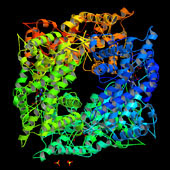P450 enzymes and “poor metabolizers.”
The finding, published in Science,
So what? Well, for starters, “cytochrome P450 enzymes are responsible for the phase I metabolism of approximately 75% of known pharmaceuticals,” write Jonathan Rittle and Michael T. Green at Pennsylvania State University’s Department of Chemistry. And in fact, only six of the more than 50 enzymes in the P450 family account for 90% of drug metabolization in humans--the compound known as CYP2D6 being the most crucial.
In a Penn State press release, lead author Michael Green, an associate professor of chemistry, noted that human populations vary widely in the version of genes they carry for P450 enzymes. According to Green, “adverse drug-drug interactions are a well-known problem…. Now that we can see those state changes on a molecular level, a deeper investigation is possible.”
The wide variation in enzymatic reactions, says Green, causes very real consequences. People with two copies of variant alleles are poor metabolizers, people with two copies of the standard genetic variety are normal metabolizers, whereas people with one of each are “reduced” metabolizers. (People who inherit multiple copies of the alleles become “ultrarapid” metabolizers.)
“With a drug such as caffeine, for example, one population of people might be fast metabolizers, while another might metabolize the drug more slowly,” Green said. "Because the risk of caffeine-induced heart attack may be higher in slow metabolizers, the ability to actually take a snapshot of the phase changes of the P450 enzymes could help us to understand better how certain chemicals can affect people in vastly different ways."
There are dozens of specific cases like the caffeine example. Moreover, the genetic situation is complicated by other factors. Writing in American Family Physician, Tom Lynch and Amy Price explain that cytochrome P450 enzymes “can be inhibited or induced by drugs, resulting in clinically significant drug-drug interactions that can cause unanticipated adverse reactions or therapeutic failures. Interactions with warfarin, antidepressants, antiepileptic drugs, and statins often involve the cytochrome P450 enzymes.” Testing for these interactions is expensive, and “it has not been determined if routine use of these tests will improve outcomes.”
Not a pretty picture. And just to further complicate matters, some drugs can induce or inhibit CYP450 enzymes differentially, depending upon the dosage. “For instance,” write Lynch and Price, “sertraline (Zoloft) is considered a mild inhibitor of CYP2D6 at a dose of 50 mg, but if the dose is increased to 200 mg, it becomes a potent inhibitor. Inhibitory effects usually occur immediately.” Also, drugs can be metabolized by, and at the same time serve to inhibit, the enzyme in question, as in the case of erythromycin.
So it is buyer beware, and listen to your body’s feedback when embarking on a course of new drugs. Recommended dosages are just that: recommendations. If you feel that the drug in question is doing too much or too little, ask your prescribing doctor about drug-drug interactions and about fast and slow drug metabolizers. Of course, they should be telling YOU about that, but.
Some known enzymatic drug interactions to bear in mind:
Drugs that potentially inhibit P450 enzymes—Tagamet, Cipro, Luvox, Prozac, Flagyl, Benadryl, Paxil, Lamisil, and grapefruit juice.
Drugs that potentially increase the activity of P450 enzymes—Tegretol, phenobarbital, tobacco, Dilantin, rifampin, St. John’s wort.
------
Adverse drug-drug interactions involving P450 enzymes:
Amiodarone (Cordarone) combined with Warfarin (Coumadin): possible bleeding due to increased warfarin activity.
Tegretol, phenobarbital, and Dilantin combined with contraceptives containing ethinyl estradiol: possible unplanned pregnancies due to reduced contraceptive activity.
Clarithromycin, erythromycin, and telithromycin combined with Zocor: possible muscle disorders due to increased Zocor levels.
Prozac combined with Risperidone (Risperdal): increased risk of adverse effects from the antipsychotic drug risperidone.
Grapefruit juice combined with Buspirone (Buspar): Dizziness and other effects of “serotonin syndrome” due to increased buspirone activity.
Rittle, J., & Green, M. (2010). Cytochrome P450 Compound I: Capture, Characterization, and C-H Bond Activation Kinetics Science, 330 (6006), 933-937 DOI: 10.1126/science.1193478
Graphics Credit: http://elcamino.dnadirect.com/

